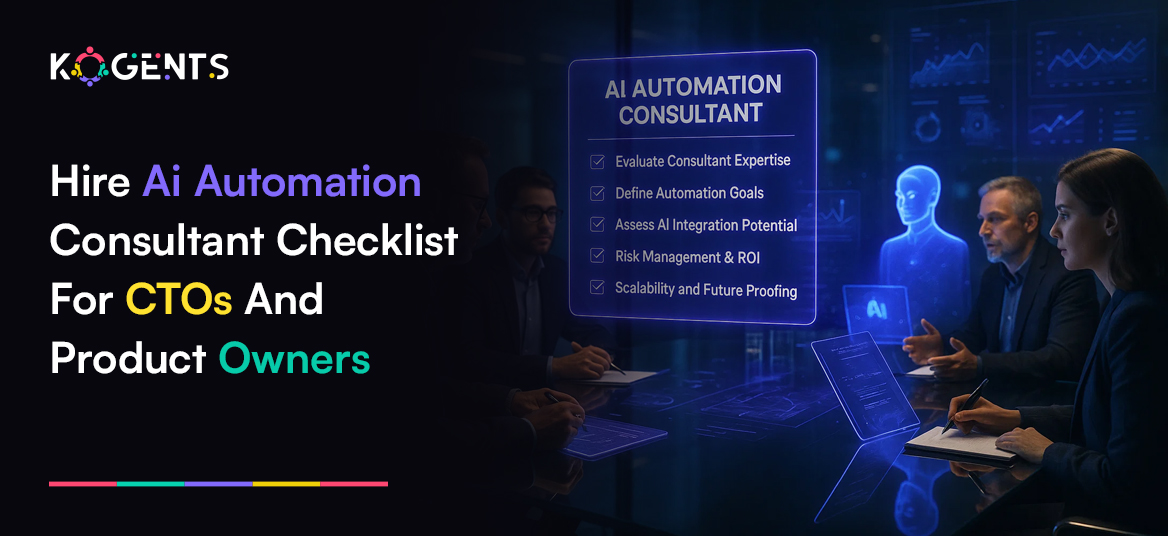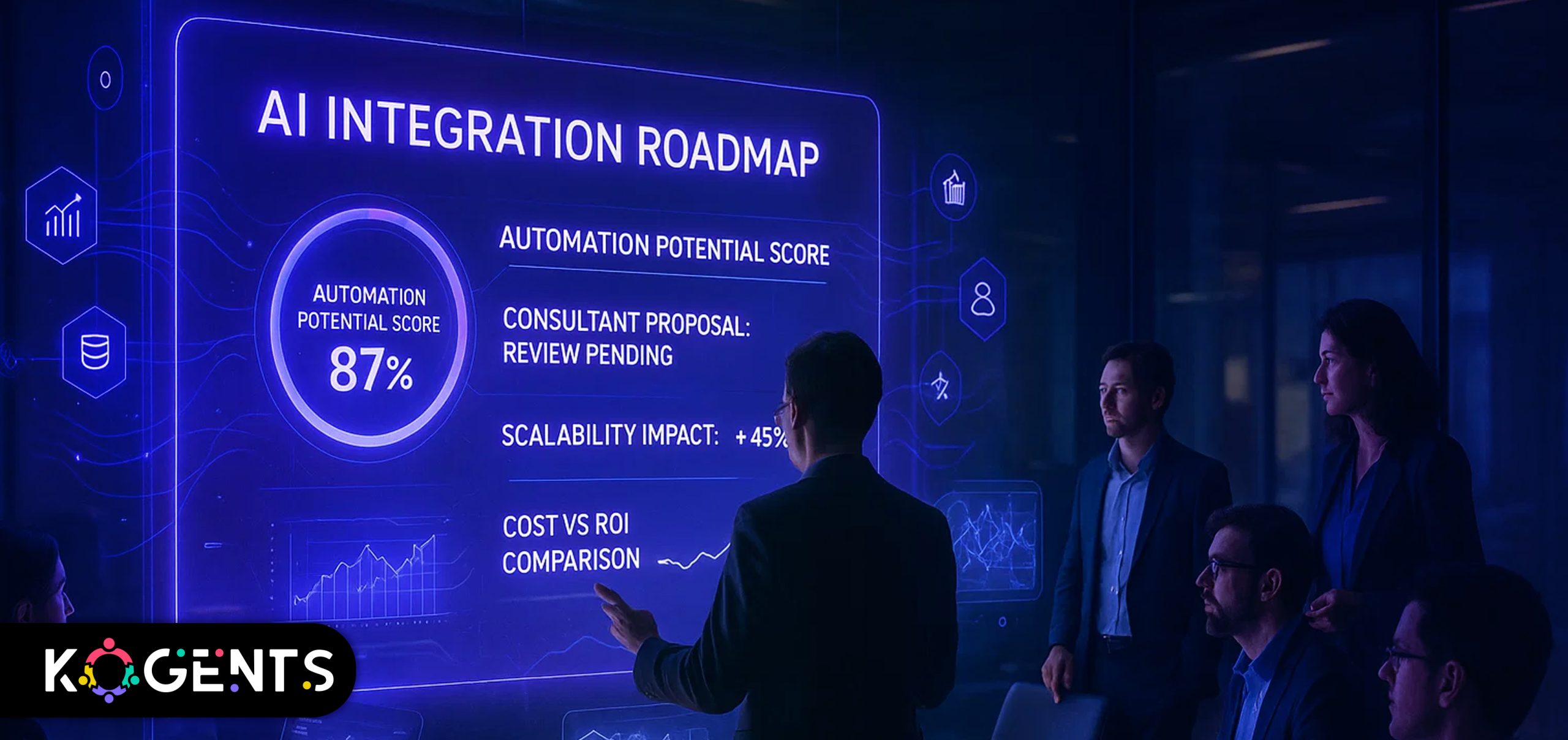Hire an AI Automation Consultant Checklist for CTOs and Product Owners

Summary:
At the heart of the current automation revolution lies a class of AI architectures called GPT decoders, the very foundation of modern generative and intelligent automation systems.
GPT (Generative Pre-trained Transformer) models rely on decoder-only transformer architectures that learn context, reason through complex workflows, and generate intelligent actions or content.
These decoder models are now embedded across automation platforms, powering intelligent document processing, chatbot orchestration, predictive workflows, and decision automation.
In essence, what used to be “rules and triggers” in traditional automation is now contextual reasoning and adaptive intelligence driven by GPT-like architectures.
This means hiring an AI automation consultant today isn’t just about implementing scripts or RPA bots; it’s about bringing in expertise that understands AI-first automation, where GPT-style reasoning and data-driven intelligence enhance efficiency, precision, and scale.
As a CTO or product owner, this guide provides you with the complete checklist to evaluate, hire, and manage the right AI automation consultant, one who can translate these technologies into measurable business outcomes.
Key Takeaways
- AI automation consulting is no longer about tools; it’s about embedding reasoning intelligence into workflows.
- The best consultants combine data, ML, automation, and change-management capabilities.
- Define KPIs and governance upfront to avoid failed pilots or scope creep.
- Evaluate consultants for end-to-end capability, from architecture to scale.
- Plan for a Centre of Excellence (CoE) to sustain and expand automation internally.

Why Engage an AI Automation Consultant?
The Business Case
Over 78% of enterprises report active AI deployment initiatives.
These numbers highlight a simple truth: automation is now table stakes, and intelligence is the differentiator.
An AI automation consultant bridges three key challenges:
- Translating business goals into automation opportunities.
- Integrating AI/ML capabilities into legacy and cloud workflows.
- Designing scalable architectures with governance, ethics, and measurement built in.
Core Benefits
| Benefit | Description |
| Operational Efficiency | AI automation can cut manual tasks by 60–95%, reducing error rates dramatically. |
| Scalability | Consultants design reusable frameworks for multi-department rollouts. |
| Data Utilisation | Converts unstructured data into actionable insights via AI/ML. |
| Governance & Compliance | Embeds auditability, ethics, and regulatory compliance. |
| Time-to-Market | Enables faster feature releases and AI for customer service automation response cycles. |
What a True AI Automation Consultant Does?
A high-impact consultant’s role spans technical, strategic, and organisational layers.
1. Strategy and Assessment
- Audit current workflows, data maturity, and readiness.
- Build a target operating model for automation.
- Define clear business outcomes (cost, speed, accuracy, CX).
2. Process Mining & Value Mapping
- Identify high-ROI automation candidates.
- Use process-mining tools and stakeholder interviews.
- Quantify savings potential and impact.
3. Technical Architecture
- Design automation stack: RPA, APIs, GPT-based models, IDP, orchestration engines.
- Integrate data pipelines, AI models, and decision logic.
- Ensure scalability, monitoring, and security.
4. Implementation
- Build and deploy AI-driven workflows and bots.
- Validate against KPIs and iterate through feedback loops.
- Manage human-in-the-loop processes for quality control.
5. Governance & Change Management
- Define ownership, escalation, and monitoring processes.
- Set up compliance frameworks and ethical AI practices.
- Train internal teams for sustainability and hand-off.
6. Continuous Optimisation
- Measure post-deployment ROI.
- Detect model drift or workflow decay.
- Scale automation across departments through CoE.

Pre-Engagement Checklist for CTOs & Product Owners
Before you even shortlist a consultant, ensure your organisation’s readiness.
1. Organisational Readiness
- Leadership alignment on automation strategy.
- Documented key processes and value streams.
- Accessible, governed data sources.
- IT architecture is ready for API-driven integration.
- Budget and resources aligned with the scope.
2. Define Business Outcomes
- Set quantitative goals (e.g., 40% cycle-time reduction).
- Determine ROI horizon (usually 12–18 months).
- Choose KPIs that include cost saved, time saved, quality uplift, and CX improvement.
3. Technology Landscape
- Assess current automation and AI tools.
- Identify compatibility or integration gaps.
- Prioritise platforms that support GPT-powered or transformer-based AI features for adaptive automation.
4. Risk & Compliance
- Data privacy and residency requirements.
- Model transparency and explainability.
- Access control and audit logs.
5. Change-Management Readiness
- Do teams understand “automation as augmentation”?
- Is there resistance to change? Plan training early.
Selection Criteria: How to Choose the Right Consultant?
Selecting the right partner determines your automation success.
| Criterion | What to Look For | Pro-Tip |
| Domain Expertise | Experience in your vertical and process type. | Check live case studies, not slides. |
| End-to-End Capability | Data, AI, RPA, orchestration, and change management. | Prefer full-stack over niche vendors. |
| Methodology | Structured roadmap: discovery → pilot → scale. | Ask for documented frameworks. |
| Outcome Focus | Business KPIs, ROI alignment, not just deliverables. | Insist on measurable metrics in the contract. |
| Tech Independence | Vendor-agnostic, modular architecture. | Avoid lock-in and proprietary silos. |
| Governance & Ethics | Compliance, bias management, and explainability. | Evaluate security posture and certification. |
| Cultural Fit | Collaborative, transparent, agile mindset. | Check team compatibility during interviews. |
Pro-Tip: Prioritise consultants who emphasise knowledge transfer. The goal isn’t dependency, it’s empowerment.
Contracting and Governance Essentials
Once you select a consultant, lock in clarity with strong contracting and governance.
Core Contract Elements
- Scope of Work: Defined processes, deliverables, and timelines.
- KPIs: Quantitative performance metrics (time, cost, accuracy).
- Ownership/IP: Ensure your organisation owns code and data.
- Payment Model: Milestone-based or value-based preferred.
- Change Management: Specify escalation path and approval process.
- Support: Post-go-live monitoring, maintenance, and retraining.
Governance Framework
- Steering Committee – Senior leadership overseeing progress.
- Project Governance – PMO, consultant lead, process owner roles.
- Change Control Board – Prevents uncontrolled scope creep.
- KPI Dashboard – Live tracking of success metrics.
- Review Cadence – Biweekly or monthly retrospectives.
Soft Reminder: Strong governance turns automation into a managed investment, not an uncontrolled experiment.
Implementation Phase: What to Expect & How to Avoid Pitfalls?
Typical Workflow
- Discovery: Assess data, processes, and readiness.
- Pilot Build: Develop 1–3 priority workflows.
- Validation: Measure KPIs, refine automation.
- Scale: Roll out to other business areas.
- Optimise: Monitor, retrain, and expand CoE.
Common Pitfalls And Prevention Tricks
| Pitfall | Prevention |
| Undefined KPIs | Set measurable business metrics pre-pilot. |
| Poor Data Quality | Conduct a thorough data audit and cleansing. |
| Scope Creep | Use phase-gated delivery with clear sign-offs. |
| Change Resistance | Communicate vision, train staff early. |
| Vendor Lock-in | Demand open standards, exportable assets. |
| No Post-Launch Ownership | Plan CoE and skill transfer from the start. |
Pro-Tips
- Focus on quick wins for early credibility.
- Implement AI explainability dashboards for transparency.
- Design modular automations that can evolve with GPT upgrades.
- Document every workflow for audit and retraining ease.
Post-Engagement and Scaling
Automation value compounds with scale. Yet, many firms stop at the pilot stage.
Scaling Strategy
- Build a Centre of Excellence (CoE):
- Internal team for governance, templates, and best practices.
- Shared services for automation pipeline and reuse.
- Create an Automation Catalogue:
- Prioritise processes by ROI and complexity.
- Use dashboards to visualise progress.
- Establish Continuous Monitoring:
- Track automation uptime, error rate, cost savings, and ROI.
- Implement feedback loops for retraining AI models.
- Govern for Sustainability:
- Audit processes quarterly.
- Monitor model drift and regulatory compliance.
- Review KPIs annually to align with business strategy.
- Upskill Internal Teams:
- Data literacy, bot operations, and prompt engineering for GPT tools.
- Create automation “champions” within business units.
Case Studies
Case 1 — Public-Sector Modernisation
A U.S. state transportation department worked with EY to Automated customer service solution renewals and registrations.
Results:
- 12 million transactions processed via AI-enabled portal.
- 300k employee hours saved.
- USD 14 million cost reduction.
Lesson: Start small but measure impact rigorously.
Case 2 — Insurance Hyper-Automation
A global insurer deployed GPT-powered automation for claims.
Results:
- 72% faster processing.
- 65% fewer manual reviews.
- USD 4.2 million annual savings.
Lesson: Combine AI document processing with orchestration for end-to-end speed.
Case 3 — Enterprise Workflow Optimisation
A multinational enterprise used an AI consultant to map repetitive tasks and automate scheduling and reporting.
Results:
- 40% faster reporting cycles.
- 30% cost savings.
Lesson: Prioritise cross-department automation for cumulative gains.
Comprehensive Hiring Checklist
| Category | Key Question | Ready? |
| Strategy Alignment | Is automation linked with business goals? | ☐ |
| Data Readiness | Are data sources clean and accessible? | ☐ |
| Process Maturity | Are workflows documented and measurable? | ☐ |
| Consultant Experience | Proven record in a similar domain/scale? | ☐ |
| Technology Fit | Compatible, scalable, GPT-capable stack? | ☐ |
| Governance Framework | Roles, SLAs, metrics defined? | ☐ |
| Change Management | Training and communication plan in place? | ☐ |
| Ownership/IP | Code and models owned by your org? | ☐ |
| KPI Definition | Success metrics baseline established? | ☐ |
| Post-Engagement Plan | CoE and sustainability defined? | ☐ |
Note: Use this table in RFP or due diligence sessions to ensure every box is ticked.
Conclusion
In 2025 and beyond, AI-driven automation has evolved from a competitive advantage to a core operational necessity.
But success depends less on the technology itself and more on how you hire and manage the expertise behind it.
The AI automation consultant is that critical partner, merging business logic with technical intelligence.
With this checklist, CTOs and product owners can evaluate readiness, select wisely, set measurable KPIs, and govern for long-term value.
Remember: automation done wrong adds complexity; automation done intelligently builds exponential scale.
At Kogents.ai, we help enterprises move from “doing automation” to thinking autonomously.
Our AI automation frameworks integrate GPT-based reasoning, human-in-loop control, and measurable ROI.
Ready to future-proof your workflows? Let’s build your intelligent enterprise by creating the best AI agents for customer support and automation at a time. Book your consultations now on our website!
FAQs
What is the role of an AI automation consultant?
They identify automation opportunities, design AI-driven workflows, integrate GPT/ML models, and build governance for measurable ROI.
When is my organisation ready for AI automation consulting?
When data is accessible, leadership is aligned, and target processes are measurable. Immature data or unclear goals signal “not yet.”
How is AI automation different from traditional RPA?
RPA automates rule-based tasks; AI automation adds reasoning, handling of unstructured data, and decision logic through ML or GPT models.
How long does an automation engagement take?
Pilots typically last 3–6 months; full enterprise roll-out may take 12–24 months, depending on scope.
What are the most critical selection factors?
End-to-end capability, domain expertise, governance, ethical AI, and proven metrics.
How can I calculate the ROI of automation?
Measure baseline metrics (time, cost, error) and post-implementation improvements. ROI = (Savings – Cost)/Cost × 100.
Should consultants also supply tools?
Vendor-agnostic consultants ensure flexibility; tool-providers may deliver faster but risk lock-in. Balance speed vs independence.
What risks should I anticipate?
Scope creep, poor data quality, change resistance, and vendor dependency. Mitigate with phased rollout and clear governance.
How do I ensure sustainability post-project?
Create a CoE, reuse automation assets, conduct quarterly reviews, and upskill staff.
What skills should our internal teams learn?
Process mapping, prompt engineering, bot monitoring, governance, and continuous improvement techniques.

Kogents AI builds intelligent agents for healthcare, education, and enterprises, delivering secure, scalable solutions that streamline workflows and boost efficiency.